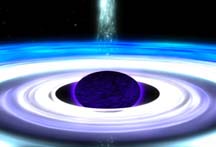This computer-generated image shows an artist's conception of a black hole. The event horizon is depicted as the black sphere in the middle of the picture. The surrounding disk of gas, represented by white and blue rings, whirls around the black hole at different speeds, with the material closest to the black hole approaching the speed of light.
Click on image for full size
Courtesy of NASA
Black Holes Out for a Spin
News story originally written on May 14, 2001
Everyone is awed by
black holes. How could there be a thing that devours all light and matter around it...so that matter can never escape?!?
A new discovery has been made about black holes - some of them spin! Dr. Tod Strohmayer, a scientist at NASA, used data from NASA's Rossi X-ray Timing Explorer to show that at least some black holes spin. "Almost every kind of object in space spins, such as planets,
stars, and galaxies," said Strohmayer. "With black holes, it's
much harder to directly see that they are spinning, because
they don't have a solid surface that you can watch spin
around. We can, however, see the light emitted from matter
plunging into the black hole. The matter whips frantically
around the black hole before it is lost forever."
The specific black hole that Strohmayer was studying was a stellar black hole. A stellar black hole is one formed from a star. When stars at least 10 times the mass of the Sun cannot support themselves any longer, the stars can explode off their outer shell in a supernova explosion. There is still a lot of material left that doesn't get thrown off into space. This material collapses into a single point of infinite density. This single point is the beginning of a stellar black hole.
Because the star that formed the black hole would have been spinning, it is thought that the spin of a black hole is caused by the angular momentum of the star that formed it.
You might also be interested in:

It was another exciting and frustrating year for the space science program. It seemed that every step forward led to one backwards. Either way, NASA led the way to a great century of discovery. Unfortunately,
...more
The Space Shuttle Discovery lifted off from Kennedy Space Center on October 29th at 2:19 p.m. EST. The weather was great as Discovery took 8 1/2 minutes to reach orbit. This was the United States' 123rd
...more
A moon was discovered orbiting the asteroid, Eugenia. This is only the second time in history that a satellite has been seen circling an asteroid. A special mirror allowed scientists to find the moon
...more
Will Russia ever put the service module for the International Space Station in space? NASA officials want an answer from the Russian government. The necessary service module is currently waiting to be
...more
A coronal mass ejection (CME) happened on the Sun early last month. The material that was thrown out from this explosion passed the ACE spacecraft. The SWICS instrument on ACE has produced a new and very
...more
J.S. Maini of the Canadian Forest Service called forests the "heart and lungs of the world." This is because forests filter air and water pollution, absorb carbon dioxide, release oxygen, and maintain
...more
In late April through mid-May 2002, all five naked-eye planets are visible at the same time in the night sky! This is includes Mercury which is generally very hard to see. You won't want to miss this!
...more















